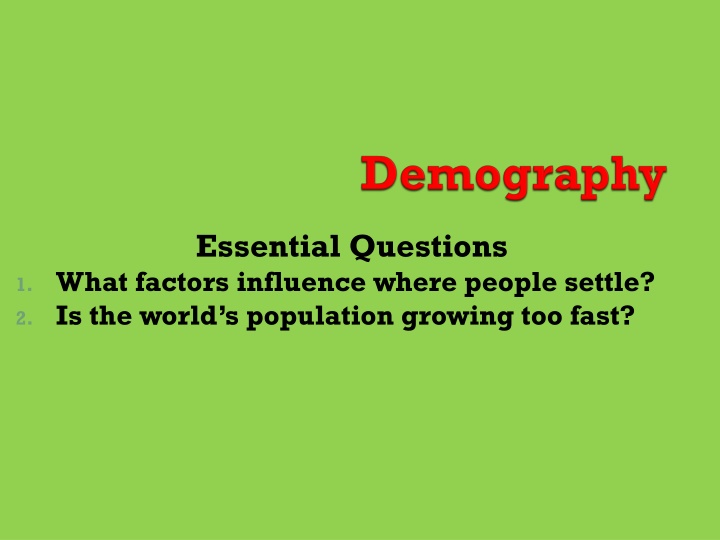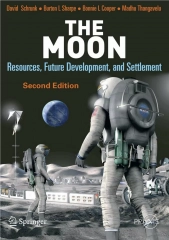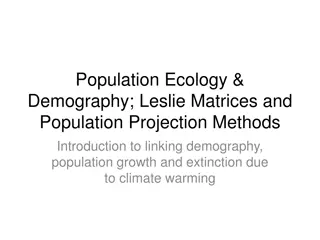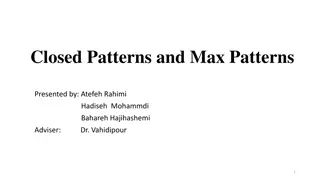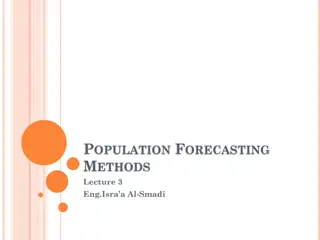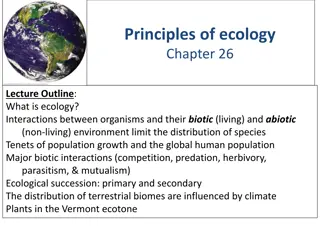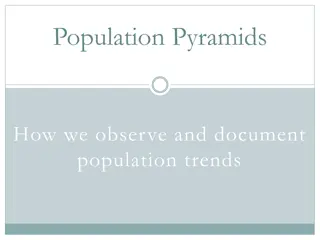Factors Influencing Settlement Patterns and Global Population Trends
Factors influencing where people settle include geographical features, political and economic centers, transportation routes, technology, and urbanization. The world's population is growing rapidly, with countries like China, India, and the United States having large populations. Additionally, life expectancy varies across countries, with some having longer life expectancies than others.
Download Presentation

Please find below an Image/Link to download the presentation.
The content on the website is provided AS IS for your information and personal use only. It may not be sold, licensed, or shared on other websites without obtaining consent from the author.If you encounter any issues during the download, it is possible that the publisher has removed the file from their server.
You are allowed to download the files provided on this website for personal or commercial use, subject to the condition that they are used lawfully. All files are the property of their respective owners.
The content on the website is provided AS IS for your information and personal use only. It may not be sold, licensed, or shared on other websites without obtaining consent from the author.
E N D
Presentation Transcript
Essential Questions 1. What factors influence where people settle? 2. Is the world s population growing too fast?
People lived nomadic lifestyles. Agriculture caused people to settle in areas near water. Nile Valley, Mesopotamia, Indus Valley, Huang He Valley
People tend to settle in temperate, fertile, non-mountainous areas, such as valleys and plains. People settle near sources of fresh water. People settle not too far from oceans. Fewer people settle in dry, wet, cold or mountainous areas.
Political and Economic Centers: People move to areas of political or economic importance, such as capital cities. Transportation Routes: People often settle along transportation routes, such as coastlines, rivers, canals, railroad lines, or roads.
Technology: Improvements in technology can expand areas of settlement. Urbanization: Since the start of the Industrial Revolution, urbanization (people moving from the countryside to cities) has increased greatly.
1. China 1.3 Billion 2. India 1 Billion 3. United States 296 Million 4. Indonesia 242 Million 5. Brazil 186 Million
1. China 1.346 Billion 2. India 1.241 Billion 3. United States 312 Million 4. Indonesia 238 Million 5. Brazil 197 Million
The 10 countries with the longest life expectancy Hong Kong 85 Japan 79 Canada 78 Iceland 78 Greece 78 Italy 78 France 77 Channel Islands 77 Australia 77 Austria 77 1. In which country do people live the longest? 2. Why is the U.S. not on this list? Guess: How long are you expected to live?
The 10 countries with the shortest life expectancy Guinea-Bissau 39 Sierra Leone 43 Afghanistan 43 Guinea 44 Malawi 44 The Gambia 45 Angola 46 Uganda 46 Rwanda 46 Niger 46 In which country do people have the shortest lives? 2. How long is a baby born in Guinea-Bissau expected to live? 3. How much shorter a life does a person live in Guinea-Bissau than in Hong Kong? Hong Kong 85 Guinea 39 46 years
A map showing how many people live per square mile in a given area. It shows the distribution of population in that area.
Uses dots to indicate the location of major towns and cities. Dots are also used to show the concentration of where people live.
These compare the numbers of males and females in a particular country. Stacked bars indicate the number of people for each age group. They are used by demographers to show the age distribution in a society.
The worlds population has steadily increased over time. Pre-Industrial: The world s population grew slowly. After Industrial Revolution: The world s population grew rapidly. Europe and N. America grew fastest due to new farming methods and industrialization.
European Colonization: As Europeans colonized new areas, they spread new farming methods and modern medicine. Current Trends: Population growth has greatly accelerated. China, India, and Africa are struggling to reduce birth rates to bring population under control.
1. Identify 2 ways you would expect Japan and Iran to have different needs because of the different ages of their populations. Japan will have to cope with an aging population so health services for the elderly will be in demand. Iran s population is very young. Iran s life expectancy is very short.
2. Physical features often influence where people live. Which type of environment typically has the highest population density? A. hills, mountains and plateaus B. Flat, fertile plains and river valleys C. Wet bogs and swamps D. Dry and barren desert regions Answer: B
3. Which of the following is the most likely effect of building a railroad to reach an area rich in natural resources? A. Railroad owners take control of the area. B. The number of people that settle in the area increases. C. There is a sharp increase in movement away from the area. D. Government leaders close the area to future settlement. Answer: B
